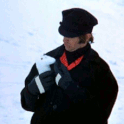Question about yeast
My Mom always insisted on dissolving yeast in water before adding it to the ingredients. I notice many of the bread recipes say just add yeast to dry ingredients. Does it make a difference to dissolve first?
10 Comments
AntoniaJamesMay 18, 2011
And just for the record, from a home baker who's made several hundred loaves of bread a year for going on two decades . . . as long as you get active dry yeast into the dough with the bread's liquid ingredients, before too much flour has been added, you actually don't need to proof it, if you are reasonably sure that the yeast is still good. I read a while back though, in James Beard's "Beard on Bread" (I think), that he recommended proofing because it results in better flavor. So I've started proofing again. For years, though, I just stirred the yeast into the liquid ingredients (but not directly in buttermilk, as its high acidity affects the performance of the yeast). Active dry yeast does not need much time in the liquid to dissolve the outer coating. ;o)
sdebrangoMay 18, 2011
This really good some really helpful information. I never really knew the difference between instant and active dry yeast and used them interchangeably without knowing what I was doing, Now I do. Thanks to all of our resident experts.
lapadiaMay 18, 2011
Hi mcd2! Love your excellent choice of words = "the thing to remember is that yeast is yeast"
Also, thanks for sharing the Cook Thesaurus link, invaluable yeast information! :)
Also, thanks for sharing the Cook Thesaurus link, invaluable yeast information! :)
mcd2May 18, 2011
my understanding of yeasts is that any kind of yeast can be used in any recipe. active yeast comes in packets or cakes (a kind available before powdered yeast was available). instant or rapid rise yeast comes in packets also (marked as such). they are all usually sold at the same place on the grocery shelf. (sourdough is another leavening method but we'll focus on off the shelf yeast for this answer.)
the caviat though is that the METHOD of preparing the yeast differs and the amount has to be adjusted per the kind used. so once you know the conversions, any yeast can be substituted for any other in the equivalent amount & method to match a recipe. so if an old recipe, for instance, says x amount of cake yeast, the yeast used does not need to be cake yeast but an equivalent of the yeast you have on hand or available. or if a newer recipe specifies rapid rise yeast, slower yeasts can be used but they will rise more slowly & that has to be accounted for.
(an aside, rapid rise yeasts have only been on the market since the late 70's/early 80's. they were designed to shorten the rise times. back then, they were "proofed" in water like the older cake & powdered active yeasts. i quit baking about that time & lost track of the point at which rapid rise yeast started to be added to dry ingredients. maybe when dough hooks were an attachment to mixers!?)
anyway, although it seems confusing to understand all the terminology of this, the thing to remember is that yeast is yeast.
it's preparation and conversion that you need to be concerned about . there is a wonderful website called food subs or cooks thesaurus that is great for equivalents and substitutions of ingredients. look there to learn more about this subject (and how to use them interchangeably):
http://www.foodsubs.com...
i hope that helps with a little overview of why the different terms exist in different recipes & what to do about the confusion.
the caviat though is that the METHOD of preparing the yeast differs and the amount has to be adjusted per the kind used. so once you know the conversions, any yeast can be substituted for any other in the equivalent amount & method to match a recipe. so if an old recipe, for instance, says x amount of cake yeast, the yeast used does not need to be cake yeast but an equivalent of the yeast you have on hand or available. or if a newer recipe specifies rapid rise yeast, slower yeasts can be used but they will rise more slowly & that has to be accounted for.
(an aside, rapid rise yeasts have only been on the market since the late 70's/early 80's. they were designed to shorten the rise times. back then, they were "proofed" in water like the older cake & powdered active yeasts. i quit baking about that time & lost track of the point at which rapid rise yeast started to be added to dry ingredients. maybe when dough hooks were an attachment to mixers!?)
anyway, although it seems confusing to understand all the terminology of this, the thing to remember is that yeast is yeast.
it's preparation and conversion that you need to be concerned about . there is a wonderful website called food subs or cooks thesaurus that is great for equivalents and substitutions of ingredients. look there to learn more about this subject (and how to use them interchangeably):
http://www.foodsubs.com...
i hope that helps with a little overview of why the different terms exist in different recipes & what to do about the confusion.
boulangereMay 18, 2011
OK, slowed down and actually read your response. Your recipe calls for active dry. Dissolve in tepid water. Instant yeast is (a) much more finely ground than active dry, but more importantly (b) developed and bred to reproduce much more rapidly than active dry. Instant yeast is usually available in wholesale packs only to the baking trade. If you'll go to my page and send me an email with your address, I'll gladly send you some instant along with conversion instructions for measurement. I get lots of it as professional samples, and am happy to share it around.
boulangereMay 18, 2011
If it's active dry, yes, do go ahead and activate it in tepid water. Where does your recipe come from? It sounds like it's written for instant yeast, but please check the ingredient list first. Let me know if it specifies active dry. If not, I have another instruction for you.
SKKMay 18, 2011
OK boulangere, this is unraveling a mystery. The recipe I have been follwing called for active dry yeast - which I used with an expiration date of Oct 2012, Fleischman. The recipe did not call for first dissolving the yeast, the back of the package did. So do I follow the back of the yeast package or the bread recipe?
boulangereMay 18, 2011
Active dry yeast needs to be activated by dissolving in water before proceeding. Instant yeast can simply be added to the dry ingredients. I think the yeast labeled Rapid Rise in grocery stores also instructs you to add it to the dry ingredients. Yeast production is very reliable. Check the expiration date of your yeast (it's stamped somewhere on the packet/container). As long at it's within its dates, you can be sure it is viable.
pierinoMay 18, 2011
By dissolving the yeast in luke warm water you are "proofing"it. That is you are checking that it's still active. A little bit of sugar helps to. You don't want to waste a batch of dough if your yeast is dead.
Showing 10 out of 10 Comments
Recommended by Food52
Popular on Food52
Continue After Advertisement





